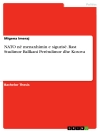This book discusses the perceptions India has about its South Asian neighbours, and how these neighbours, in turn, perceive India. While analyzing these perceptions, contributors, who are eminent researchers in international relations, have linked the past with present. They have also examined the reasons for positive or negative opinions about the other, and actors involved in constructing such opinions.
In 1947, after its independence, India became part of a disturbed South Asia, with countries embroiled in problems like boundary disputes, identity related violence etc. India itself inherited some of those problems, and continues to walk the tight rope managing some of them. Traditionally, seventy years of India’s South Asia policy can roughly be categorized into three overlapping phases. The first one, Nehruvian phase, which viewed the region through a prism of an internationalist; the second one, ‘interventionist’ phase, tried to shape neighbours’ policies to suit India’s interests; and the third, accommodative phase, when policy makers attempted to accommodate the demands of the neighbours in India’s policy discourses. These are not ossified categories so one can find that policy adopted during one phase was also used in the other.Keeping the above in mind, the book discusses India’s role in managing and navigating through challenges of the presence of external, regional and international, powers; power rivalries in South Asia; India’s maritime policy and her relationship with extended neighbours; and India being visualized as a soft power by South Asian countries. It will certainly appeal to the academicians, students, journalists, policy makers and all those who are interested in South Asian politics.
Innehållsförteckning
Section I : India’s Relationship with Neighbours: History, Politics and Perceptions.- Chapter 1: Pakistan: As Perceived in India.- Chapter 2: India’s Perception of Bangladesh and Indo-Bangladesh Relations: Examining the Internal Dynamics in India .- Chapter 3: ‘Perceptions and Policies’: The State of India – Sri Lanka Relations. – Chapter 4: India Nepal relations in the New Asian Order .- Chapter 5: India-Bhutan Relations: Challenges and Prospects .- Chapter 6: Perceptions on India-Maldives Relations Over the Decades .- Chapter 7: India’s Relationship with Afghanistan .- Section II: Neighbours Relationship with India: History, Politics and Perceptions.- Chapter 8: Understanding Pakistani Perspective in the Prism of Pak-Indo Relations.- Chapter 9: The Dynamics of Bangladesh-India Relations: Paradigm Shift and New Challenges. – Chapter 10: Nepal India Relations: In a Critical Juncture. – Chapter 10: Afghans’ are divided over their Perception of India. – Chapter 11: Contemporary Indo–Sri Lanka Bilateral Relations from Pragmatic Perspectives. – Chapter 12: Bhutan-India Relations: Shifting Perceptions, Challenges and Prospects. - Section III: India and the Region.- Chapter 13 : India’s engagement with SAARC Nation : A study of Environmental issues in SAARC .- Chapter 14: ‘Indian foreign policy and extra-regional powers’. – Chapter 15: India’s Maritime Security and Policy: An Imperative for the Blue Economy .- Chapter 16: Rise and Growth of India’s ‘Extended Neighbourhood’ Worldview .- Chapter 17: India as a Soft Power.
Om författaren
Dr Amit Ranjan is a Visiting Research Fellow with the Institute of South Asian Studies (ISAS), National University of Singapore. Prior to joining ISAS, Dr Ranjan worked as a Research Fellow at the Indian Council of World Affairs, New Delhi, India. He completed his doctoral studies at Jawaharlal Nehru University, India
.












